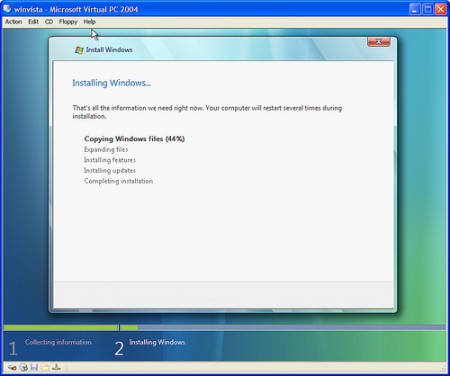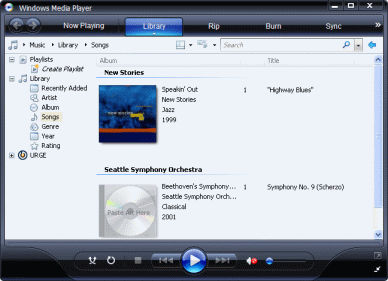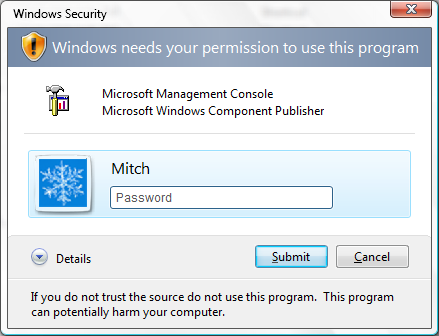Is there life on vista
 Vista is one of the most controversial products from the Redmond giant. On the one hand, the world wide web is filled with cries of “fi!” And humor on this subject, on the other hand, a lot of copies have been sold, although most of them, of course, are pre-installed OSs.
Vista is one of the most controversial products from the Redmond giant. On the one hand, the world wide web is filled with cries of “fi!” And humor on this subject, on the other hand, a lot of copies have been sold, although most of them, of course, are pre-installed OSs.So is there life in this sector of the IT-galaxy, or will it start only by forcing users (by not supporting XP)? Or should a UFO arrive and erase this part of it? .. As they say, it’s better to install once than read a disclaimer a hundred times.
So, for purely study purposes a month ago, I set myself Vista Ultimate (not into a virtual machine, but physically on a laptop).
0. Objectives of the article
')
The article does not analyze the deep internal structure of the new version of the windows operating systems line. It mainly tells about its user-end part, changes in usability, standard programs and the part of security relating to the user (for it is known that the greatest security threat to a computer is sitting in front of its screen).
I will say in advance that I work under windows. I say in advance - no, this is not advertising. I anticipate critics, saying that I know what Linux is, I did more than one project on it and its ideology is also close to me and Linux is installed by the second system.
Thank you for understanding. I hope the material will be interesting.
So…
1. Installation
They say the installation has become faster ... In relative terms, of course yes (mb / s), but in absolute terms - the same time.
They say the installation has become more beautiful ... and to whom Malevich's Square is an art.
In my opinion, the installation is normal, Windows, it has become more convenient somewhere, it has become more glamorous everywhere, but in general it is about the same. And all the same interest can not be considered. And the description of operations is increasingly degrading to the inscriptions of the form “I am preparing for the next step” (25%) and “Doing what I need” (75%)

I was only pleased with the reduction in the number of questions asked.
2. Work in the system
After 40 minutes of waiting and three restarts, the system is installed. Well, the topic Aero saw everything long before the release of whists. I will not focus on it, although it is much better compared to the standard WinXP theme. I can only say that on a modern video card (Ati x1400) I noted that GUI drawing via DirectX in Vista (occurs when Aero is on) or through OpenGL in Linux (Compiz Fusion) is faster than using 2D tools.
2.1. Interface and built-in features
Quite a lot has been recycled in this field. And I'm not talking about fashionable big icons on the desktop, but, for example, about a seriously redesigned file selection window. Finally, it became possible to add your own folders to Favorites - in the file selection window on the left (as in KDE and Gnome), the address line (everywhere in the system) was conveniently reworked, a quick search appeared right in this window. Frankly, all this was long overdue, although we will be more lenient: XP was released back in 2001.
Interface improvements have touched dozens of little things like the desktop selection window, although it would seem that you see it once a year on a big holiday, but what has been since 1994 and has not changed - it seems convenient until you see a new one. What is the same standard mixer that can adjust the sound for any (compatible, of course) applications that use sound, separately.

Or take the help system. It finally stopped being incomprehensible for what it was made by the braking application with a blue icon, which everyone was afraid to accidentally fall on. Now it works - in the sense that it starts in sane time and you can search and find solutions in it, and those who are able to use search engines will do it fairly quickly (although not always)! Yes Yes! I still do not believe it myself, and often torment her with questions ...
There is a built-in power management (which is important for laptops). In XP, it is almost there (without third-party utilities). Now you can create separate profiles (although I’m working around one) and set limits for the processor, video card, network card, set the time to stop the screw, turn off the screen, etc., etc. for both mains and battery operation.
2.2. Work with the network
What pleased me most was the work with the network. She's great. In XP, everything was much worse - not very sane settings wizards, half of which are now replaced by the Network Settings Center, problems in different groups (one at home, the other at work) that are now forgotten — successfully find and show workstations from all groups, even those to which your car does not belong. And it does it all with one list and goes well when you write in Win-> Run "\\ machine1" for a machine from another subgroup. Finds the gateways, according to UPnP determines what devices. (if UPnP is enabled of course). The network settings manager often helps not to bother - it is made as for an inexperienced user and performs its function. Including in it functions are finally taken out (Like Password protected sharing) which in XP were not taken out explicitly.
It is also positive that Vista
2.3. Standard programs
Standard windows programs have always been its strength and disadvantage.
In Vista, they are significantly replenished - and this is the main advantage. The main disadvantage is that the existing ones for a long time have practically not changed. For example, notepad and mspaint still look the same people from 1995 on whom they pulled the skin, and Windows Mail - the old Outlook Express in a new wrapper. However, in Vista and in addition to them there is something to see.
Windows media player

I needed an audio player. I have about 6000 songs. I didn’t think that I would ever write something like that - but sorting through several players and having an unforgettable Amarok image in my head - stopped at WMP.
It has a very convenient library with various sorting and filters, quick search, loading covers from an Internet and auto playlists - what else do you need?
Although you really need to - editing normal playlists is left as usual - with your left foot through your right ear, but you can get used to it for the rest. In general, both for the bundled program - very, very much. ( upd: now I use Aimp2 - I found everything I was looking for in it)
Windows Photo Gallery

Just chic. Charming photo manager. There is everything you need - by date, and by folders, and rating and tags, and several editing options (red eye, cut, color, photo rotation).
Slide Show has become much prettier and more manageable. There were effects in the show. Pan & Zoom taxis! All this works quickly and beautifully.
Windows firewall
It has finally become possible to create your own rules with your hands! In XP, the firewall was an incomprehensible link to the network environment - it was almost impossible to use, which most did - it was simply turned off - and installed Outpost, Kerio, etc.
And although this is not Outpost and not Kerio (and of course not iptables :)), nevertheless, a pretty good basic setting is available. For the average user - already something.
3. Security
Separately, I want to mention this item. It would seem - in the security system, nothing has changed. And fundamentally it is. However, the approach to security has seriously changed - and I think it is for the better.
First of all, when installing the system, they force everyone to sit under the administrator’s account - and this is plus number one! But in my opinion, this is not enough - and the developers would force everyone to initially sit under the user, but due to the fact that many programs do not yet support such a system (they need to ask permission to access system folders), and users will not understand why they are not set (we will not lie to ourselves - windows is designed for an inexperienced user) - then all the same, they first sit under the admin. And although, of course, the system automatically detects attempts to access system folders or functions requiring administrative rights in Vista, after which the system itself makes a request, even if the program itself was not going to do this, it does not always save.
But still - it’s time to put the user under the user account (even it sounds logical). Yes - you have to confirm actions, yes - under the user (standard) account you also have to enter the password to the admin account, but under Linux, after all, it’s not a bummer to type the password in sudo (gksudo, kdesudo)? And safety increases at times!
I personally deliberately moved under the user account, on distribution kits I set myself the right to add only. After all, for simplicity - suppose a situation that the antivirus missed the virus, and he began to nibble ... nibble ... and what nibble? System folders are closed, distributions for changes - too, ... ask for permission? :)

Immediately anticipate criticism that soon, soon, the evil hackers will find holes for privilege escalation and everything will fly to hell. Maybe. In my memory in XP, I found only one - in GetAtom, which was successfully closed in SP2. In Vista have not yet found. Until then, it’s a major security improvement. But the most important thing that allowed us to sit under the user is the ability to launch the program at any time quickly with administrator privileges from the context menu. It was the absence of this feature that blocked XP from the path to the same thing. Reboot under another account, or create a shortcut, go to properties, etc. etc. It was so long that everyone was just too lazy to do it. And in vain.

“Do not sit under the root!” - the first commandment of the Linuxuid. Perhaps now the windows users too ...
4. Disadvantages
It should be noted and disadvantages.
The most important flaw in the user interface for me personally was the fact that the new SegoeUI font is disgustingly smoothed by the Standard method. I don't like the ClearType method and I turn it off. And everything would be fine, but in many parts of the interface it is simply impossible to change the font with standard tools - they are “sewn” into the theme! This, for example, applies to a new start menu, control panel, help, etc.
Also, some standard utilities for some reason have lost parts of the functional - for example, the defragmenter now shows neither progress nor colored strip-indicator of fragmentation - sit, they say, wait, when I finish - I will say this. A standard voice recorder can now save only in wma. As already mentioned, mspaint, which in our time in this functionality is easily implemented on javascript + canvas, didn’t move from one place to another, but there are more powerful designs.
Many admin tools are missing in the versions below Ultimate. For example, the Microsoft Management Console is trimmed in all Home versions. The Aero interface is not available in versions below Home Premium.
For some reason, the Ukrainian language does not work correctly in many old applications (for example, qip).
And, of course, all this is flavored by the fact that there is no wide interface setting - although from the point of view of standardization this may be justified.
4. Conclusion
There are users who, on Windows XP, set themselves the black theme of ala Vista, VistaORB for a button, icons for Vista, a bunch of bells and whistles, and they think that now they have “almost Vista” - after all, in Vista, nothing has changed except for ryushechek .
I really hope that many people understand what has changed more than the theme of the desktop. And let it not be called the “next step” (what many expected from Vista, and how Microsoft itself positioned it), but it is still a qualitative step forward.
The main disadvantage of the new-fashioned system, in my opinion, is its price. With all due respect to the labor expended - in my personal user experience and pocket - these new developments of the extra money that the Redmond software giant wants to reap from millions of users and from me personally are not worth it. Still, extra 200-250 dollars on the road are not lying. Maybe in a year ...
Source: https://habr.com/ru/post/17160/
All Articles